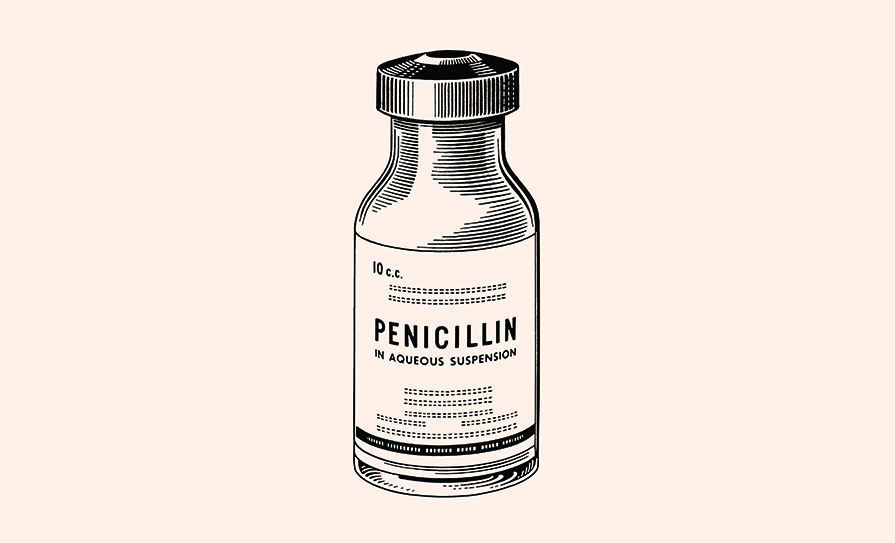The name of Alexander Fleming will always rightly be synonymous with penicillin. Fleming is an interesting character all on his own – this seventh child of a Scottish hill farmer graduated from school at age 16. Imbued with a fascination for bacterial mechanisms since early in his medical life, he embarked on a military career, serving as a captain in the British Army Medical Corps during World War I. In 1915, he married an Irish woman, Sarah Marion McElroy, and they had a son who went on to become a GP.
Even during his military service, Fleming somehow continued his research and really got stuck in after the army was demobilised. He went to work looking at antibacterial substances which would not be toxic to animal tissues and in 1921, he discovered a vital bacteriolytic substance that he named lysozyme. At the same time, he was working on sensitivity titration methods and assays in human blood and other bodily fluids, which he subsequently used as a titration method for penicillin.
The rest, as they say, is history. He stumbled across the discovery of penicillin while working on the influenza virus in 1928 after he left a Petri dish containing a Staphylococcus culture by the window. Fleming observed that the mould that developed had created a bacteria-free circle around itself and this inspired him to investigate further. He discovered that a mould culture prevented the growth of staphylococci, even when diluted up to 800 times.
But in truth, that’s just part of the story. When Fleming was awarded the Nobel Prize in Physiology or Medicine in 1945, he was joint recipient along with Dr Howard Walter Florey and Dr Ernst Boris Chain, two scientists who were instrumental in developing penicillin further and getting it ready for the bedside.
A proud Australian, Florey was also quite a tennis player and that, along with a stellar academic record, earned him a Rhodes Scholarship to study at Oxford University.
As for Chain, his father was a pharmacist and an industrialist. He was also interested in biochemistry from an early age and worked on enzyme research for three years at the Charité Hospital, Berlin. When the Nazis rose to power in 1933, Chain emigrated to England, where he studied at Cambridge and Oxford.
Discovering penicillin was one thing, but producing it in sufficient quantities in a form that was safe for patients was another. Florey’s and Chain’s paths crossed and at Florey’s suggestion, Chain began studying lysozyme and in 1938 became acquainted with Fleming’s work on penicillin. The two began making penicillin in porcelain vessels and built ‘penicillin farms’ – the process was laborious, with hundreds of litres of what was termed ‘mould juice’ required to produce a few milligrams of solid penicillin. So much of this ‘juice’ was required that the team was forced to use bedpans, milk churns, food tins, and even bathtubs to store the broth.
Florey recruited a crew known as the ‘penicillin girls’, who ‘farmed’ the substance. These six women – Ruth Callow, Claire Inayat, Betty Cooke, Peggy Gardner, Megan Lancaster, and Patricia McKegney – tirelessly farmed the broth. However, it took three gruelling years before they devised a slow and inefficient process to develop pure penicillin.
The first patient was treated in 1941, a 43-year-old policeman with a life-threatening infection from a cut. He recovered briefly, but the supply of penicillin quickly ran out and his infection returned – he died five days later.
Clearly, supply was a critical issue and the team had to resort to drastic measures. Approximately 80 per cent of a dose of penicillin is excreted in urine and can be extracted and recycled. The penicillin girls, along with Florey’s wife, Dr Ethel, were regularly to be seen cycling to visit patients and collect their precious urine.
Fleming was not short of critics and scoffers. Many peers ridiculed his early ideas on the power of penicillin, and indeed, he himself abandoned his studies into it for a time. It was not until more than a decade after his discovery that the full potential of penicillin became apparent. Just maybe, without the contributions of the less famous Florey and Chain, the timeline might have been different and a lot more lives would have been lost.













Leave a Reply
You must be logged in to post a comment.